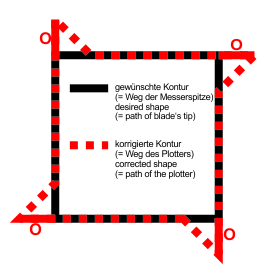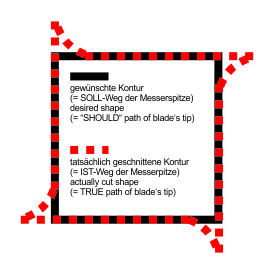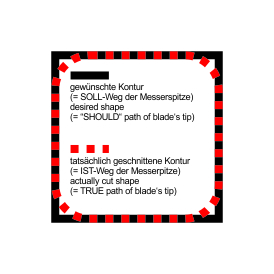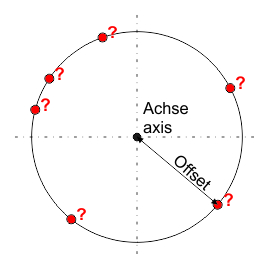Plotter blades: Offset Compensation? |
GIS Premium Blades |
|
Offset compensation for drag blade plotters |
||
Offset compensation ? |
Offset is set too big | Offset is set too small |
 |
 |
 |
| The offset value set on the plotter is greater than the actual offset value on the blade. The plotter travels further beyond the corner than would be necessary for exact compensation. Artificial tips are created. | The offset value set on the plotter is smaller than the one actually present on the blade. The correction made by the plotter is not large enough. The corners of the contour are rounded. | |
| With drag knife plotters, the tip
of the drag blade is displaced from the center by the offset
dimension "O". This causes the blade to be aligned in the cutting
direction. The tip therefore follows the axis of the plotter by this
distance "O", what usually has to be compensated. This is done
automatically by the control of "real" cutting
plotters. With modified drawing plotters or CNC milling machines
with drag blades, the contour can be corrected by the CAM program or
by means of a special program (e.g. "Skalp") before the file is
plotted. IMPORTANT is with all drag blade plotters that the offset value that is set actually corresponds to that of the blade. If necessary, make a test cut with a square and change the offset setting on the plotter until the corners are exactly right-angled. |
||
Initial problem: Where is the tip of the drag blade? |
||
 |
A special problem of the drag knife
plotter is that at the beginning of a figure to be cut it is random
at first where the tip of the blade is, because the blade is freely
rotatable in the blade holder. Only one thing is certain: the tip is
somewhere on a circle around the axis of the blade holder with the
radius corresponding to the true offset value. Only after a plotted path of slightly more than 1 x offset the tip is definitely "behind" the axis. The result is that at the beginning of the figure it has a random contour over a short distance. Usually the plotters are controlled in such a way that this unsafe initial part is plotted again after closing the contour to ensure that the contour is really closed and can be safely weeded. Conclusion: For very fine objects, you should select offset values that are as small as possible in order to keep these unavoidable initial errors small. Hint: For particularly filigree work, you can plot a short line (in later waste) before plotting the actual contour, the alignment of which corresponds to the start of the following contour (if you know where your software sets the starting point). Then the knife is already aligned in the corresponding direction. |
|
|
GIS Gienger Industrie-Service GmbH
• Max-Eyth-Str. 14 • D - 78194 Immendingen Tel. +49-(0)7461-1620 20 • Fax. +49-(0)7461-1620 21 • |
||
| |